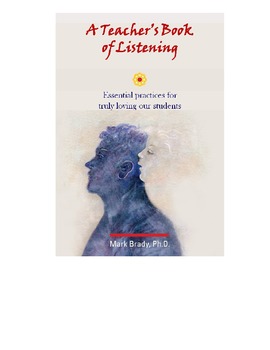A Teacher's Book of Listening PDF
Mark Brady
9 Followers
Grade Levels
9th - 12th, Higher Education, Adult Education, Homeschool, Staff
Subjects
Resource Type
Formats Included
- PDF
Pages
116 pages
Mark Brady
9 Followers
Description
Mark Brady, Ph.D.
mark.brady@sofia.edu
For some people using the ears only to hear seems good enough. For others, learning to develop a deep capacity to listen, to detect nuance, to catch subtlety, to discern what isn’t being said, offers a wealth of riches. Here are just a few deep listening benefits:
It offers rich means for discerning the good, the true, and the beautiful.
Changeux, J.- P., (2008). The good, the true, and the beautiful.
New Haven, CT: Yale University Press.
It operates in effective ways to help settle ourselves and calm others.
Fosha, D., Siegel, D., & Solomon, M. (2009). The healing power of emotion.
NY: W.W. Norton.
It provides a powerful method for increasing “neuroceptive” awareness.
Porges, S.P. (2013), Clinical insights from polyvagal theory: The transformative
power of feeling safe. NY. W.W. Norton.
It operates as a critical element in generative creativity.
Senge, P. et al, (2008). Presence: Human purpose and the field of the future.
NY: Crown Business.
It delivers an unparalleled means for facilitating thinking fast and slow.
Kahneman, D. (2011). Thinking fast and slow. NY: Farrar, Straus and Giroux.
It affords the most direct access to the 10th cranial nerve governing our emotional life.
Davidson, R. N. and Blakeslee, S. (2012). The emotional life of your brain. NY: Hudson Street.
It can offer clear perspectives to help stop bullying left brain deceptions.
Bolte-Taylor, J. (2009). My stroke of insight. NY: Plume
It provides an excellent means of cultivating mindsight and executive function.
Siegel, D. S. (2010). Mindsight. NY: Bantam.
It can work to dissolve the illusion of the separate self.
Hood, B. (2012). The self illusion: How the social brain creates identity.
NY: Oxford University Press.
mark.brady@sofia.edu
For some people using the ears only to hear seems good enough. For others, learning to develop a deep capacity to listen, to detect nuance, to catch subtlety, to discern what isn’t being said, offers a wealth of riches. Here are just a few deep listening benefits:
It offers rich means for discerning the good, the true, and the beautiful.
Changeux, J.- P., (2008). The good, the true, and the beautiful.
New Haven, CT: Yale University Press.
It operates in effective ways to help settle ourselves and calm others.
Fosha, D., Siegel, D., & Solomon, M. (2009). The healing power of emotion.
NY: W.W. Norton.
It provides a powerful method for increasing “neuroceptive” awareness.
Porges, S.P. (2013), Clinical insights from polyvagal theory: The transformative
power of feeling safe. NY. W.W. Norton.
It operates as a critical element in generative creativity.
Senge, P. et al, (2008). Presence: Human purpose and the field of the future.
NY: Crown Business.
It delivers an unparalleled means for facilitating thinking fast and slow.
Kahneman, D. (2011). Thinking fast and slow. NY: Farrar, Straus and Giroux.
It affords the most direct access to the 10th cranial nerve governing our emotional life.
Davidson, R. N. and Blakeslee, S. (2012). The emotional life of your brain. NY: Hudson Street.
It can offer clear perspectives to help stop bullying left brain deceptions.
Bolte-Taylor, J. (2009). My stroke of insight. NY: Plume
It provides an excellent means of cultivating mindsight and executive function.
Siegel, D. S. (2010). Mindsight. NY: Bantam.
It can work to dissolve the illusion of the separate self.
Hood, B. (2012). The self illusion: How the social brain creates identity.
NY: Oxford University Press.
Total Pages
116 pages
Answer Key
N/A
Teaching Duration
N/A
Report this resource to TPT
Reported resources will be reviewed by our team. Report this resource to let us know if this resource violates TPT’s content guidelines.





